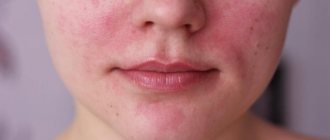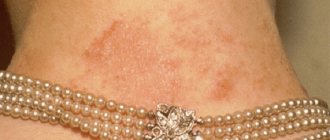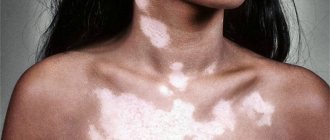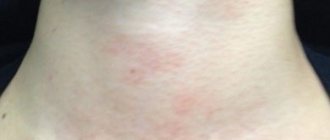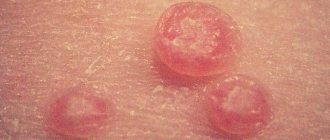Photo of skin plaques
There are many reasons for the appearance of corresponding pathological elements. The problem is not always just diseases of the dermis. Liver plaques on the skin, allergic, and autoimmune may occur. Even oncology sometimes causes the appearance of pathological elements.
Depending on their shape, plaques are:
- Round.
- Oval.
- Irregular shape.
If plaques appear on the skin, they may initially be smooth and flat, but over time they become convex and rough. It all depends on the characteristics of the specific pathology.
In the photo below you can see different types of plaques.
Dry patches on the skin
Dry plaques on the skin in adults are a sign of dysfunction of the epidermis. The rashes are characterized by differences in shape. They can have from 1-2 millimeters in diameter to 1 centimeter or more. In some diseases (psoriasis), such elements tend to merge to form entire conglomerates.
Dry plaques can occur against the background of the following processes in the human body:
- Fungal skin infection. As a result of the activity of pathogenic organisms, characteristic elements are formed. They often itch and cause a lot of discomfort to the patient. To confirm the appropriate diagnosis, it is necessary to scrape the pathological area and then examine it under a microscope.
- Allergic reaction. The appearance of flat plaques on the skin, marked by dryness, may be the body's response to exposure to a specific allergen. This development of events can be triggered by a certain food, detergent, or insect bite. The cessation of the influence of the antigen leads to a subsidence of the severity of the pathological process until its disappearance.
- Psoriasis. Autoimmune dermatosis, which is accompanied by the appearance of dry elements. As the disease progresses, the plaques on the skin flake and are constantly covered with silvery scales. The second name of the disease is “scaly lichen”. It is quite difficult to treat this pathology. It is impossible to completely get rid of it. It is possible to achieve stable remission.
- Chronic stress. Dry plaques in small quantities can be a reaction to constant nervous tension. The best treatment in this case is to limit the negative impact of stress on the patient.
- Diseases of the digestive tract. A lack of vitamins, impaired absorption of nutrients, liver disease, and an excess of a certain number of foods can lead to the formation of dry spots, which over time develop into plaques.
There are enough reasons for the appearance of dry pathological elements on the skin. The main thing is not to self-medicate, but to contact a dermatologist directly. He will be able to establish the correct diagnosis and select the appropriate treatment.
Causes of spots
There can be many provoking factors for the appearance of irritation on the neck. The causes of red spots on the neck are divided into:
- external,
- internal.
External factors include:
- The influence of stressful situations.
- Psycho-emotional overload.
- Insect, mosquito and bee bites.
- Staying in the open sun for a long time.
- Diaper rash.
- Allergic reactions. They can occur when eating certain foods or as a result of contact of the skin of the neck with a chain or scarf. Redness and itching on the neck may not appear immediately, which makes diagnosis difficult.
Endogenous factors are considered:
- Atopic dermatitis. The red spot on the neck itches and brings a lot of discomfort.
- Diseases of infectious origin, such as measles, scarlet fever, chickenpox.
- Eczema.
- Scleroderma. A red spot appears on the neck, which after a certain period of time swells and hardens. In some cases it can limit movement.
- Ringworm, red patches on the neck are itchy and can spread to the chest and shoulders.
- Hemangioma. This pathological condition is characterized by a red spot on the neck, which looks like a mole. It usually does not cause discomfort. If it grows, you need to seek qualified help as quickly as possible.
To determine why red spots appear on the neck of an adult or child, it is necessary to undergo a thorough diagnosis.
Red patches on the skin
A red or pink plaque on the skin is a sign of good vascularization of the pathological element (in most cases). Most often it looks like a small bump rising above the surface of the body. The shape and location of the pathology can vary significantly. Plaques appear almost anywhere (face, arms, ankles, body, etc.).
Potential reasons for the progression of the corresponding elements are:
- Secondary syphilis. A round plaque on the skin or mucous membrane of the mouth in the plural is one of the main manifestations of the disease. At the same time, a positive Wasserman reaction is detected.
- Dermatitis herpetiformis. This is a disease without a clearly established etiology. Its description indicates the appearance of a recurrent, itchy rash of the type of red multiple papules, plaques, and blisters.
- Mycosis fungoides. With this pathology, red plaques on the skin itch and may look like eczema. In the early stages, they respond well to treatment with hormonal ointments.
- Lichen planus. A chronic disease characterized by the appearance of small, shiny (glossy) plaques.
- Medicinal toxicodermy. Occurs against the background of the influence of certain medications. Regarded as an allergic reaction.
- Papular urticaria. Another allergy option. Mainly observed in children. The cause most often is individual intolerance to a certain type of food.
- Psoriasis. The plaques that occur as a result of this disease are pink or red in color. They are dry, flaky and can itch.
Depending on the cause that caused the appearance of the red pathological skin element, the approach to its treatment will differ. To establish an accurate diagnosis, sometimes a simple examination of the plaques is not enough. At such moments, it is necessary to perform a biopsy to determine the nature of skin changes at the histological level.
Clinical picture
Symptoms of the pathological condition will depend on the provoking factor that the neck turns red and itches.
With psychomotor disorders, redness appears on the neck; it practically does not bring any pathological sensations; in rare cases, itching may occur.
If spots on the neck appeared due to diseases of a dermatological nature, then their characteristic features are that they:
- spread to the scalp and upper limbs,
- may change, fill with exudate and peel off,
- lead to itching.
In severe cases of the disease, an increase in body temperature and a deterioration in the general condition of the person may be observed.
If the cause of the spots on the neck is an allergy, then the symptoms will be almost identical to the previous case, the only difference will be the duration of their presence and severity.
In diseases of infectious origin the following will be observed:
- neck irritation
- increase in body temperature,
- headache,
- fatigue,
- a sore throat,
- cough,
- hyperhidrosis,
- production of excessive tears,
- rash over the entire body,
- clinical picture of intoxication of the body.
The following picture will be typical for autoimmune disorders:
- a red spot appears on the neck, which itches and flakes,
- deterioration of general condition,
- feeling of general weakness,
- increase in body temperature,
- blood pressure surges,
- itching
Eczema is characterized by the formation of red spots, which, as the pathological process progresses, turn into blisters. There is a feeling of unbearable itching and peeling.
Redness on the neck in women can be accompanied by disruptions in the menstrual cycle and hormonal imbalances. Representatives of the stronger half of humanity may experience a decrease in libido and impaired potency.
If red spots appear on the neck, in any situation, you must seek medical help. It is unacceptable to start treatment on your own at home.
Brown patches on the skin
Pigmented (dark) plaques on the skin indicate the deposition of melanin pigment in the affected area. Sometimes the characteristic visual appearance is due to the oncological process. If a dark spot or bump appears on the surface of the body, you should immediately consult a doctor.
The reasons for such changes may be:
- Basal cell carcinoma (pigmented form). It most often affects the head and neck area. It grows slowly and does not metastasize.
- Melanoma . A very aggressive skin tumor that develops primarily on the basis of nevi and moles.
- Becker's nevus . This is an anomaly in the development of the upper layer of skin, which is accompanied by the formation of a dark plaque with a warty surface. Over time, hair may appear on it.
- Pigmented nevus . This is a birthmark that is brown in color and may protrude above the surface of the skin.
- Senile keratoma . This is a benign tumor. It is regarded as a precancer. Characterized by excessive growth of the surface layer of the body.
These pathological elements also include xanthomatous plaques on the skin. They have a predominantly yellowish tint. They are formed in places of excess lipid deposition.
Features of white spots on legs
The appearance of white spots on the skin of the legs is associated with a disruption in the production of melanin, the substance responsible for coloring. This may be caused by a decrease in the functional activity of melanocytes - cells that synthesize melanin, or their absence in certain areas of the skin. Melanin accumulates in the surface layer of the skin - the epidermis. Due to its deficiency or excess, pigment spots (birthmarks) and moles appear on the body, including on the legs.
White spots on the soles of the feet can be caused by infections that affect the sole, surface of the foot, or nail beds.
This is facilitated by various factors: the level of stress on the feet, poor hygiene, wearing uncomfortable shoes or untimely treatment of foot fungus.
What to do if skin plaques itch?
The appearance of any pathological elements on the surface of the patient’s body should alert him. Be it plaques on the skin similar to lichen or an incomprehensible colorless spot, an enlarged mole, and the like. In any case, you need to consult a doctor.
Sometimes it happens that while a neoplasm does not cause discomfort to a person, he tends to ignore it. However, as soon as it starts to itch or hurt, the patient immediately seeks specialized help or tries to solve the problem on his own.
The question of such people about how to reduce the intensity of itching always remains relevant. Much in this case depends on the nature of the pathological element. Only a doctor can prescribe etiotropic therapy after making an appropriate diagnosis. To quickly eliminate the unpleasant sensation, you can use the following methods and means:
- Cold . It is allowed to use a cloth moistened with water, ordinary ice, or a frozen piece of food. Sometimes the easiest thing to do is take a cold shower.
- Baking soda . Lotions with sodium bicarbonate can partially relieve the unpleasant symptom.
- Antihistamines (Diazolin, Suprastin, Loratidine and others). They are drugs that block the activity of histamine. Thanks to this, itching can be eliminated. However, in the absence of etiotropic treatment, the symptom will return over time.
- Hormonal ointments . Suppress the inflammatory process in the affected area. Effectively eliminate itching. Often included in the basic therapy of various dermatoses.
The use of medications should be supervised or after consultation with a doctor to prevent the development of side effects or complications. Self-medication is fraught with aggravation of the patient's condition.
Prevention measures
Timely treatment of the underlying disease will prevent the spread of white spots. Treatment should be supervised by a doctor.
If white spots are associated with intense exposure to sunlight, then it is appropriate to use products that protect against a painful photoreaction.
If white areas appear, you should consult a specialist, as this may be not only an aesthetic flaw, but also a symptom of an internal or dermatological disease. Particular attention should be paid to such signs if white spots appear on the legs of a child or infant.

